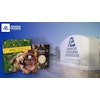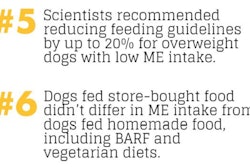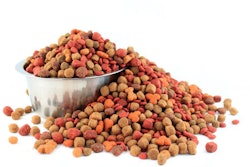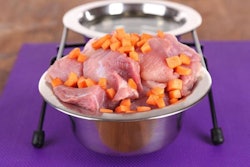
There have been a few hot topics in pet food nutrition in 2016 — most notably anything having to do with proteins (low-fat proteins, high-protein diets, alternative proteins) and the continuing industry quest to meet the health needs of an increasingly diverse pet food market (obesity and other health issues, specialty formulas based on individual animal needs). Unsurprisingly, these topics have been reflected in published research, as scientists and other experts in animal health and nutrition continue to look for answers and refine the knowledge that will carry the pet food industry forward into 2017.
Protein in pet food diets

Using mink kits in growth studies can provide valuable information in the protein quality assessment of extruded dog foods. | Andrea Gantz, WATT Global Media
Two different studies published in the September 2016 issue of the Journal of Animal Science focused on protein in dog diets. The first, “Protein and amino acid bioavailability of extruded dog food with protein meals of different quality using growing mink (Neovison vison) as a model,” evaluated mink kits as a model for dietary protein quality assessment of protein meals used in extruded dog foods. The study also tested dogs. Crude protein digestibility and amino acid composition were two of the key points of focus during the study, which used three different protein meals of varying quality: lamb meal (low protein quality), poultry meal (intermediate quality) and fish meal (high quality).
For the mink kits, the lamb meal diet showed the lowest values for nitrogen balance, body weight gain and protein efficiency ratio, deviating from the other two diets. All three diets differed in the apparent total tract digestibility of the available crude protein as well as the amino acids, with the lamb meal diet showing the lowest rates (66.8 percent digestibility for crude protein, versus 73.8 percent for poultry meal and 82.1 percent for fish meal). The dog group showed similar results, with the standardized ileal digestibility of both crude protein and amino acids differing among the three diets in the same order (71.5 percent digestibility for crude protein in the lamb meal diet, 80.2 percent for poultry meal and 87 percent for fish meal).
Overall, beyond showing that using mink kits in growth studies can actually provide valuable information in the protein quality assessment of extruded dog foods, this study shows that amino acid composition and digestibility are vital components to ensuring nutrition adequacy and comparing protein quality of those foods. These conclusions expand the possibilities for protein research and hone in on necessary pieces of that research, both necessary as protein in its various forms becomes an increasing focus in pet food formulations.
Another component of the protein focus in pet food has been alternative or non-animal sources of protein. A second study in the Journal of Animal Science researched the nutrition quality and digestibility of bioprocessed soy protein. “Apparent total tract macronutrient digestibility, fecal characteristics and fecal fermentative end-product concentrations of healthy adult dogs fed bioprocessed soy protein” had the objective of evaluating the effects of the soy protein — a processed, soy-based product with low antinutritional factor concentrations and high protein quality — on the dogs and determining whether it might be a viable replacement for poultry byproduct meal in dog food.
In the study, 48 Beagle dogs were given one of six diets with varying percentages of soy protein. In terms of palatability, the best of the three inclusion levels tested (0, 12 or 48 percent) was 12 percent, preferred by the dogs over the other two. Digestibility of dry matter, organic matter and energy didn’t differ from the control at any inclusion rate, except for a decrease at 48 percent soy protein, and apparent total tract crude protein digestibility wasn’t significantly affected (ranging from 82.9 to 86.2 percent). The study results suggest that soy protein is a suitable replacement for poultry byproduct meal in dog diets, up to a 24 percent inclusion level — something worth noting or expanding on for anyone considering alternate forms of protein in their formulas as consumer needs continue to diversify.
Mitigating the challenges of pet obesity via diet

Further research about alternative feeding arrangements could provide both veterinarians and pet food formulators with options when recommending weight-loss measures or diets. | Andrea Gantz
Pet obesity is certainly a hot topic in the pet food industry right now as consumers struggle with pets that are more overweight than ever. A June 2016 study published in the Journal of Animal Physiology and Animal Nutrition, “Obese mice on a high-fat, alternate-day fasting regimen lose weight and improve glucose tolerance” focused on the possibility of alternate-day fasting on a high-fat diet as a possibility for weight loss.
According to the study, diet-induced obese male mice lost one-third of their pre-diet body weight while on an alternate-day fasting diet for ten weeks that consisted of high-fat food. The fasting protocol also improved glucose tolerance and insulin sensitivity, although mice on a fast day were less glucose tolerant than they were on a fed day. Collectively, the fasting regimen with a high-fat diet in obese mice resulted in weight loss, and improved blood glucose control and daily fluctuations in selected physiological and biochemical parameters in the mice. It’s possible that studies like this, about alternative feeding arrangements, could provide both veterinarians and pet food formulators with options when recommending weight-loss measures or diets.
Another study, published in September 2016, studied the effects of sterilization on female dogs’ food intake, in the context of dietary fat and carbohydrate content. Animal sterilization is suggested to promote food overconsumption, which can easily lead to obesity, but it’s unknown whether the effect is mediated by variations in satiety-related hormones. “Effect of sterilization and of dietary fat and carbohydrate content on food intake, activity level, and blood satiety–related hormones in female dogs,” published in the Journal of Animal Science, took a look at all those components.
Female Beagles (one group intact, one group sterilized) were fed a high-carbohydrate diet and a high-fat diet, both high in dietary fiber, during two phases. Dog sterilization did not affect voluntary dry matter intake, challenge food intake (used as an index of the satiety state of the dogs) or blood hormones, but led to a reduced activity level compared with control dogs. In summary, dog sterilization was not associated with an impaired appetite control. Feeding dogs the high-fat diet led to energy overconsumption and to a lower blood elevation of cholecystokinin and total peptide YY, but was not associated with a weaker satiating effect compared with the high-carbohydrate diet. This data could also be of use to both veterinarians and formulators of specialty diets, when suggesting or determining serving sizes and feeding restrictions for sterilized pets.
As trends continue to evolve, it’s incumbent upon the industry to stay on top of the research — and to conduct its own — in order to ensure that consumer needs are met while maintaining the nutritional integrity of pet food that pets depend on as part of their health and wellness.
Read the studies
Protein and amino acid bioavailability of extruded dog food
Total tract macronutrient digestibility of dogs fed soy protein
Obese mice oh a high-fat alternate-day fasting regimen lose weight
Effect of sterilization on food intake in female dogs
Further industry research

















